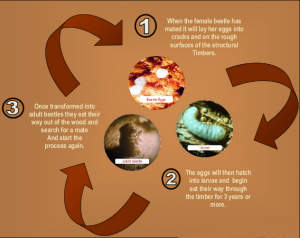Woodworm
Gen Damp are experts in all forms of Woodworm eradication. From identifying the species of beetle through to the correct treatment, you can ensure Gen Damp will treat your infestation problems efficiently and professionally.
Woodworm is a wood boring beetle that attacks timbers as part of its life cycle and left untreated can cause structural damage to your property. There are many species of wood boring insects that can attack timber in the UK.

Woodworm is a term or description used to cover all species of wood boring beetles. Unfortunately the life cycle of the woodworm has been completed before most property owners are aware they have an infestation problem. After mating the female lays her eggs into cracks and on the rough sawn surfaces of the structural timbers, these eggs hatch and begin to tunnel into the timber and feeding on the the cellulose present in wood cells. The number of eggs and the length of the larval feeding stage varies according to species. Once the larvae has finished feeding it will pupate and several weeks later the adult beetle will have developed and will begin to bore out of the timber to mate leaving flight holes which are often the first sign of an infestation. Having mated the female beetle will again lay her eggs on the timber and the life cycle begins again.

Here at Gen Damp we have decades of experience in the treatment of woodworm. Our fully trained and experienced surveyors will correctly identify the species of beetle and the necessary treatment required. With Gen Damp you can be secure in the knowledge that we will provide the correct treatment to eradicate your woodworm infestation full stop!
The four most common wood boring insects to infest properties are:
- Common furniture beetle (Anobium punctatum) by far the most common insect to infest your property here in the North East it is estimated that 75% of properties have an attack or infestation. All buildings over 30 years old are susceptible to infestation by this insect.
- Death Watch beetle (Xestobium rufovillosum) this insect can cause sever structural damage if left untreated as it is usually found in large sectioned hardwoods like roof trusses and is often associated with an attack of wet rot or moisture ingress.
- Wood weevil (euphoryium confine and pentarthrum huttoni) are insects that prefer damp conditions and decay and can be eradicated by the removal of damp conditions and the removal of the decayed timbers as dry timber will not be affected by these species.
- Wood weevil (euphoryium confine and pentarthrum huttoni) are insects that prefer damp conditions and decay and can be eradicated by the removal of damp conditions and the removal of the decayed timbers as dry timber will not be affected by these species.

Other insects found attacking timber in the UK include Bark borer beetle, Pinhole borer beetle and beetles of the Lyctus family to name but a few.







